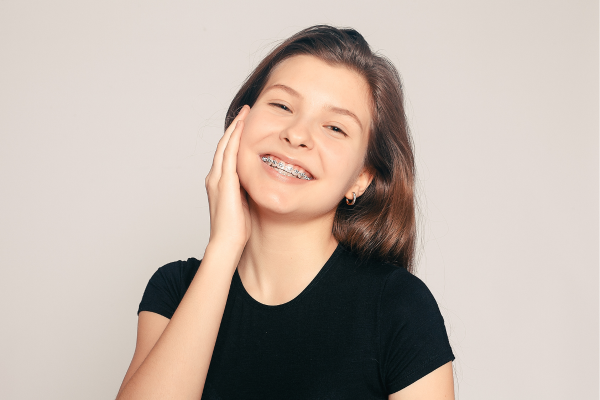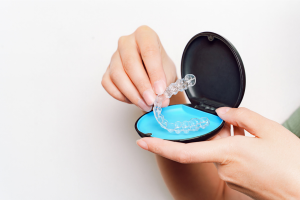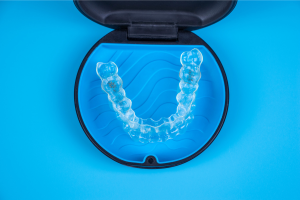For image-conscious teens, the promise of straighter teeth without metal brackets can feel life-changing. Modern invisible teeth braces (clear aligners) are discreet, removable, and designed to fit busy school, sport, and social schedules. But are they the right choice for your child? The short answer: often yes—provided the case is suitable and your teen can commit to consistent wear. Below, we unpack how invisible dental braces work for teenagers, who is a good candidate, what treatment involves, and how parents can set their child up for success.
How invisible braces work for teenagers
Clear aligners are a series of bespoke, removable trays that apply gentle, targeted forces to move teeth over time. In the UK, they’re widely used for mild to moderate orthodontic problems after a comprehensive clinical assessment by a dentist or specialist orthodontist. That “case selection” step matters: aligners are excellent for many bite and crowding issues but may not be the first choice for complex movements.
Teen-specific systems add features that help with adherence and growth changes. Many invisible braces UK providers use wear-time indicators (small blue dots that fade when the trays are worn as prescribed) so clinicians and parents can monitor compliance—useful during exam season or sports-heavy weeks.
The commitment: wear time really matters
Aligners only work while they’re being worn. Most teen protocols require around 22 hours of daily wear—removing them only for eating, drinking anything besides water, and toothbrushing. Falling short can slow progress or require extra aligners later. This isn’t scare-mongering; it’s simply how the biomechanics of invisible braces treatment work.
As a parent, the take-home is simple: if your teenager is organised and motivated, aligners can be a brilliant fit. If they repeatedly forget their trays or misplace them, a fixed option may be more predictable.
Benefits teens (and parents) tend to notice
Many families choose invisible dental braces for comfort, convenience, and confidence. Without brackets or wires, there are fewer school-day emergencies like poking wires; oral hygiene is easier because teens can brush and floss normally; and early “tenderness” after starting treatment often settles quickly. Research also suggests aligners are associated with less pain in the first days compared with fixed braces and with better oral-health-related quality of life during treatment.
Removability is another plus. Musicians and athletes appreciate being able to take trays out briefly for a performance or contact sport (mouthguards fit more easily). Day-to-day life—from photos to presentations—feels less interrupted, which is a big reason invisible braces London clinics see strong teen interest.
Where invisible braces may not be the best first choice
Clear aligners are versatile, but they’re not a panacea. Very complex tooth movements, severe rotations, significant vertical changes, or cases involving impacted teeth can sometimes be more efficiently managed with fixed appliances, at least for part of the journey. A specialist will explain if your teen would benefit from a hybrid plan (brief fixed braces followed by aligners) or a fixed-only approach. The key is an in-person assessment and a transparent discussion of options and likely outcomes.
Are results as good as with fixed braces?
Parents often ask whether aligners are “as effective” as traditional braces. Evidence in adolescents is encouraging. One study in teens with Class I and II malocclusions reported that clear aligner cases finished, on average, three months faster and required fewer visits than fixed-brace cases, with no significant difference in overall treatment efficacy—though individual results vary and careful case selection is crucial.
What really drives outcomes is the triangle of good planning, precise tray design, and consistent wear. When those three align, teens can achieve excellent, stable results with aligners.
How long does invisible braces treatment take for teens?
Timelines depend on the bite problem, crowding, and compliance, but many teen cases complete in a similar window to fixed braces—often around 12 to 24 months. Your orthodontist will map a personalised plan after digital scans and bite analysis, and they’ll estimate a timeframe and number of aligner sets.
UK pathways: private, NHS, and choosing a clinic
In the UK, orthodontic treatment is available on the NHS for under-18s who meet specific clinical criteria; not every teen will qualify, and availability varies. Many families therefore explore private invisible braces UK options for greater choice, convenience, or a faster start date. Whether you’re in London or elsewhere, the fundamentals are the same: make sure your clinician is GDC-registered, ask about experience with teen cases, and request a clear written plan covering goals, estimated duration, and what’s included (refinements, retainers, and reviews).
If you’re searching for invisible braces in London, compare more than price. You can visit our clinic or book an appointment online with our expert orthodontists for faster resolution.
What the treatment journey looks like
After an orthodontic assessment, your teen will have a digital scan or impressions. The clinician plans tooth movements in stages; small tooth-coloured “attachments” may be placed on certain teeth to help the trays grip and move them predictably. Your teen changes to a new set every week or two, attends periodic reviews, and may use elastics for bite correction. Wearing time, oral hygiene, and keeping trays safe become the three big habits.
Because aligners are removable, the risk of plaque build-up and gum inflammation is typically lower than with fixed appliances—if your teen maintains good brushing and flossing. Your clinician will also discuss retainers; wearing them as directed after treatment is essential to protect the result.
Helping your teen succeed with aligners
Parental support makes a real difference. Build tray-wear routines around school timetables and meals; set reminders on phones or smartwatches; keep a labelled case in every school bag and sports kit; and encourage your teen to communicate if a tray feels loose or a button comes off so it can be fixed promptly. These small systems help teens hit that 22-hour target consistently.
If motivation dips—as it sometimes does—ask your clinic about progress photos or mid-course scans. Seeing measurable changes can reignite buy-in. Some teen systems’ wear indicators offer an extra nudge and objective feedback during check-ups.
Bottom line: are invisible braces suitable for your teen?
For many adolescents, yes. Invisible teeth braces are a proven, patient-friendly route to straighter teeth when the case is appropriate and your teen can commit to wearing aligners as prescribed. They’re discreet, comfortable, and can deliver excellent results with fewer day-to-day disruptions—particularly appealing during the formative secondary-school years. The best next step is a consultation with a GDC-registered clinician experienced in teen aligner care to confirm suitability and map a plan tailored to your child.






